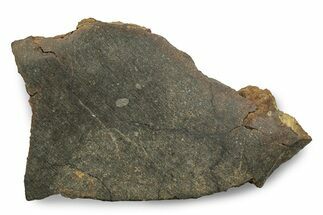This Specimen has been sold.
1.1" Allende Chondrite Meteorite (2.6 g) Slice - Mexico
This is one of the coolest specimens we've ever had on this site: a 1.1" wide (2.6 gram) slice of the carbonaceous chondrite (CV3) known as Allende. Allende was witnessed as a huge meteor shower known as Pueblito de Allende on February 8, 1969. Over 100 kilograms of this stunning chondrite fell over a 50-square-kilometer area near the town of the same name. This is the largest carbonaceous chondrite ever found on Earth!
This slice shows off Allende's complex interior expertly. It contains gray and bluish chondrules set into a dark matrix, accompanied by a large whitish calcium-aluminum rich inclusion (CAI) on one side.
This meteorite is old, too: they contain tiny diamonds that likely formed from the death of a star before our solar system even formed. Allende is considered at least as old as the solar system itself, but could be up to 12 billion years old!
This slice shows off Allende's complex interior expertly. It contains gray and bluish chondrules set into a dark matrix, accompanied by a large whitish calcium-aluminum rich inclusion (CAI) on one side.
This meteorite is old, too: they contain tiny diamonds that likely formed from the death of a star before our solar system even formed. Allende is considered at least as old as the solar system itself, but could be up to 12 billion years old!
What Is A CV3 Chondrite
A CV3 chondrite meteorite is a specific type of stony chondritic meteorite belonging to the "CV" (Carbonaceous Vigarano) group. CV chondrites are named after the Vigarano meteorite, a famous meteorite that fell in Italy in 1910. The "3" designation in CV3 signifies its petrologic grade, indicating that it has undergone minimal thermal alteration and remains in a relatively pristine state since its formation over 4.5 billion years ago.
CV3 chondrites are rich in carbon and may contain organic compounds and amino acids, hinting at the building blocks of life. They also contain small spherical inclusions called chondrules and refractory inclusions that formed at high temperatures in the early solar nebula. They often have a distinctive, dark matrix with embedded chondrules and metal grains. Some contain white calcium-aluminum-rich inclusions (CAIs), which are among the oldest solid materials in the solar system. CV3 chondrites provide crucial insights into the early solar system. Their relatively unaltered state helps scientists study the solar nebula's conditions and processes, and they’re valuable for understanding pre-solar chemistry.
A CV3 chondrite meteorite is a specific type of stony chondritic meteorite belonging to the "CV" (Carbonaceous Vigarano) group. CV chondrites are named after the Vigarano meteorite, a famous meteorite that fell in Italy in 1910. The "3" designation in CV3 signifies its petrologic grade, indicating that it has undergone minimal thermal alteration and remains in a relatively pristine state since its formation over 4.5 billion years ago.
CV3 chondrites are rich in carbon and may contain organic compounds and amino acids, hinting at the building blocks of life. They also contain small spherical inclusions called chondrules and refractory inclusions that formed at high temperatures in the early solar nebula. They often have a distinctive, dark matrix with embedded chondrules and metal grains. Some contain white calcium-aluminum-rich inclusions (CAIs), which are among the oldest solid materials in the solar system. CV3 chondrites provide crucial insights into the early solar system. Their relatively unaltered state helps scientists study the solar nebula's conditions and processes, and they’re valuable for understanding pre-solar chemistry.
TYPE
Carbonaceous Chondrite (CV3)
LOCATION
Chihuahua, Mexico
SIZE
1.1 x .95 x .08", 2.6 grams
CATEGORY
ITEM
#265988
 Reviews
Reviews












